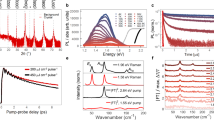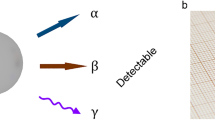Abstract
Bismuth germanate (Bi4Ge3O12 or ‘BGO’), primarily because of its higher detection efficiency, is beginning to replace NaI(Tl) as a scintillator for detection of γ rays in several applications, including large electromagnetic calorimeters for high-energy physics experiments1, computed tomography systems in medical physics2 and γ-ray spectroscopy measurements in oil-well logging3. Although the use of BGO is increasing, the scintillation mechanism which converts incident γ-ray energy into visible light is not well understood and its efficiency (light output per unit energy of absorbed γ radiation) decreases following exposure to ultraviolet light or other radiation4. We have found that this ultraviolet ‘radiation damage’ is accompanied by a corresponding increase in a stored thermoluminescence signal—the first reported observation of thermoluminescence in BGO. Comparison of scintillation efficiency and thermoluminescence intensity following various exposures to ultraviolet light and after thermal annealing indicate a strong correlation between the scintillation efficiency and the electron population of the thermoluminescence traps. This should be a useful probe for investigating the scintillation mechanism of BGO.
This is a preview of subscription content, access via your institution
Access options
Subscribe to this journal
Receive 51 print issues and online access
$199.00 per year
only $3.90 per issue
Buy this article
- Purchase on Springer Link
- Instant access to full article PDF
Prices may be subject to local taxes which are calculated during checkout
Similar content being viewed by others
References
Bakken, J., Isaila, M., Piroue, P., Stickland, D. & Sumner, R. IEEE Trans. Nucl. Sci. 31, 180–183 (1984).
Cho, S. H. & Farukhi, M. R. J. nucl. Med. 18, 840–851 (1977).
Schweitzer, J. S. Proc. Int. Workshop Bismuth Germanate Physics Dep. Rep., 696–697 (Princeton University, 1982).
Bobbink, G. J. et al. SLAC-PUB-3339, 3rd Int. Conf. Instrumentation Colliding Beam Physics (Novosibirsk, USSR, 1984).
Horowitz, Y. S. Thermoluminescence and Thermoluminescent Dosimetry (CRC, Boca Raton,Florida, 1984).
Birks, J. B. The Theory and Practice of Scintillation Counting (Pergamon, Oxford, 1964).
Maccio-Serpia, P., Rucci, A. & Serpi, A. J. Luminescence 9, 488–501 (1975).
Author information
Authors and Affiliations
Rights and permissions
About this article
Cite this article
Melcher, C. Thermoluminescence and radiation damage in bismuth germanate. Nature 313, 465–467 (1985). https://doi.org/10.1038/313465a0
Received:
Accepted:
Issue Date:
DOI: https://doi.org/10.1038/313465a0
This article is cited by
Comments
By submitting a comment you agree to abide by our Terms and Community Guidelines. If you find something abusive or that does not comply with our terms or guidelines please flag it as inappropriate.



